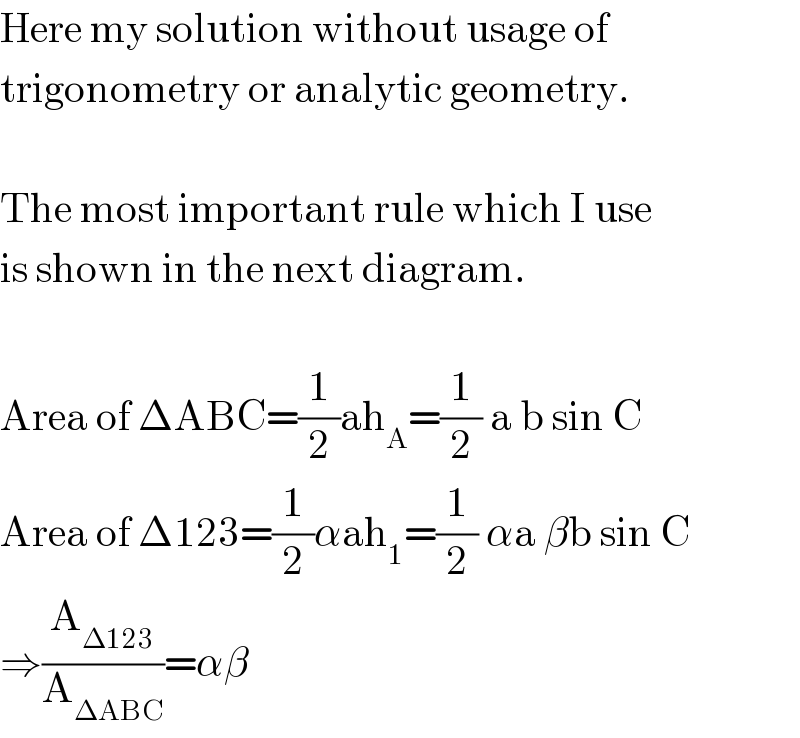Question Number 14940 by mrW1 last updated on 05/Jun/17

Commented by mrW1 last updated on 05/Jun/17

Commented by b.e.h.i.8.3.4.1.7@gmail.com last updated on 06/Jun/17

Commented by mrW1 last updated on 06/Jun/17

Commented by mrW1 last updated on 06/Jun/17

Commented by ajfour last updated on 06/Jun/17

Commented by mrW1 last updated on 06/Jun/17

Commented by ajfour last updated on 06/Jun/17

Commented by mrW1 last updated on 06/Jun/17

Commented by mrW1 last updated on 06/Jun/17

Commented by mrW1 last updated on 06/Jun/17

Commented by b.e.h.i.8.3.4.1.7@gmail.com last updated on 07/Jun/17

Commented by mrW1 last updated on 07/Jun/17

Answered by ajfour last updated on 07/Jun/17

Commented by mrW1 last updated on 07/Jun/17

Commented by mrW1 last updated on 07/Jun/17

Answered by mrW1 last updated on 08/Jun/17

Commented by mrW1 last updated on 08/Jun/17

Commented by mrW1 last updated on 08/Jun/17

Commented by mrW1 last updated on 08/Jun/17

Commented by mrW1 last updated on 08/Jun/17

Commented by mrW1 last updated on 08/Jun/17

Commented by mrW1 last updated on 08/Jun/17
![We introduce some auxiliary lines: CK parallel to IF CJ parallel to HB ΔCJG is similar to ΔHBG ⇒((JG)/(BG))=((CG)/(HG)) ⇒JG=((CG)/(HG))×BG=(1/(n−1))×BG=(a/(n−1)) ΔKCG is similar to ΔFIG ⇒((KG)/(FG))=((CG)/(IG)) ⇒KG=((CG)/(IG))×FG=(1/n)×((LG)/2)=(1/n)×((na)/2)=(a/2) ΔADF is similar to ΔACK ⇒((AD)/(AF))=((AC)/(AK)) ⇒AD=((AF)/(AK))×AC=((LF−LA)/(AG−KG))×AC =((((na)/2)−a)/(na−a−(a/2)))×AC=((n−2)/(2n−3))×AC ΔAEB is similar to ΔACJ ⇒((AE)/(AC))=((AB)/(AJ)) ⇒AE=((AB)/(AJ))×AC=((AB)/(AG−JG))×AC =((na−2a)/(na−a−(a/(n−1))))×AC=((n−1)/n)×AC DE=AE−AD=((n−1)/n)×AC−((n−2)/(2n−3))×AC =(((n−1)/n)−((n−2)/(2n−3)))×AC =(((n−1)(2n−3)−n(n−2))/(n(2n−3)))×AC =((n^2 −3n+3)/(n(2n−3)))×AC Using our rule abov we get A_(ΔDEB) =((DE)/(AC))×A_(ΔACB) =((n^2 −3n+3)/(n(2n−3)))×((n−2)/n^2 )=(((n^2 −3n+3)(n−2))/(n^3 (2n−3))) Area of hexagon: A_H =A_(ΔMHB) −3×A_(ΔDEB) A_H =((n^2 −3n+3)/n^2 )−3×(((n^2 −3n+3)(n−2))/(n^3 (2n−3))) =((n^2 −3n+3)/n^2 )[1−((3(n−2))/(n(2n−3)))] =((n^2 −3n+3)/n^2 )[((n(2n−3)−3(n−2))/(n(2n−3)))] =((n^2 −3n+3)/n^2 )[((2n^2 −6n+6)/(n(2n−3)))] =((2(n^2 −3n+3)^2 )/(n^3 (2n−3)))](https://www.tinkutara.com/question/Q15247.png)
Commented by b.e.h.i.8.3.4.1.7@gmail.com last updated on 08/Jun/17

Commented by b.e.h.i.8.3.4.1.7@gmail.com last updated on 08/Jun/17

